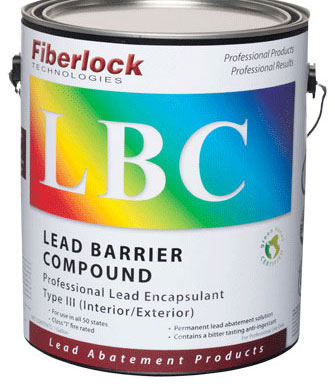
















We would like to welcome you to the Lead Abatement Product Center web site. We carry Lead Remediation, Lead Restoration, & Lead Removal products. Our staff is here to help you in any way that we can. 100% Customer Satisfaction is our number one priority. So if you are unsure of what product is best for your project call us toll free at 1-800-227-8479.
| • Lead Paint Remediation | • Lead Paint Stabilization | • Lead Paint Encapsulation |
Click here for the new 2010 Lead Law: Product Guide & Information (.pdf)
Beginning in April 2010, federal law will require that contractors performing renovation, repair and painting projects that disturb lead-based paint in homes, child care facilities, and schools built before 1978 must be certified in the new EPA Renovation, Repair & Painting Rule (RRP) and follow specific work practices to prevent lead contamination. Visit www.epa.gov/lead/ for more information regarding the new lead laws.
Those who have already completed a one-day Lead Safe Work Practices course or lead abatement certification are eligible to complete the Remodelers Refresher course. Any prior Lead Safe Work Practices training is not sufficient to meet the requirements of this new Federal Law. After April 22, 2010, the EPA, or a state agency enforcing the regulations, can fine a company $37,500 per infraction, per day. The new rules also render companies vulnerable to the threat of a civil suit for noncompliance.
Lead Renovation, Repair and Painting Program information can be found by visiting: EPA's Lead Renovation, Repair and Painting Program.
Lead is a toxic and hazardous metal found in our environment. It can be found in water and soil, dust, air, and in products such as paint. It was used for many years in homes, bridges, warehouses; specifically in paint. The U.S government had banned the use of lead based paints in 1978.
Lead is a hazardous and toxic metal that was used for many years in products found in and around our homes. Lead also can be emitted into the air from motor vehicles and industrial sources, and lead can enter drinking water from plumbing materials or such things as bridges. According to the US Consumer Product Safety Commission, lead may cause a range of health effects, from behavioral problems, learning disabilities, hearing problems, and stunted growth. In adults, it can cause nerve damage, irritability, poor muscle coordination to seizures and death. It can also cause problems with reproduction. Children six years old and under are most at risk.
Concern over lead based paint poisoning has drawn intense attention over the past couple of years. The news has spotlighted many recalls from overseas manufacturers that use lead paint on children’s toys. Although this may be true and frightening to many parents with small children, many people unknowingly have lead based paint within their homes, especially if built before 1978, particularly in areas such as door frames, woodwork and windowsills.
| • Deteriorating lead-based paint | • Lead contaminated dust | • Lead contaminated residential soil |

Lead-based paint has been banned since 1978, but many older structures still have this paint on walls, woodwork, siding, windows, and doors. Construction and demolition workers can be exposed to lead contamination by cutting, scraping, sanding, heating, burning, or blasting lead-based paint from building components, metal bridges and metal storage tanks. In addition to exposure to workers, lead-based paint debris or dust can also make its way into soil, potentially contaminating surface waters. Lead poisoning is a serious health threat for adults and is especially damaging to young children.
Abatement means any measure or set of measures designed to permanently eliminate lead-based paint hazards. Abatement includes, but is not limited to:
1. The removal of lead-based paint and lead-contaminated dust, the permanent enclosure or encapsulation of lead-based paint, the replacement of lead-painted surfaces or fixtures, and the removal or covering of lead contaminated soil; and
2. All preparation, cleanup, disposal, and post-abatement clearance testing activities associated with such measures.
3. Abatement does not include renovation, remodeling, landscaping or other activities, when such activities are not designed to permanently eliminate lead-based paint hazards, but, instead, are designed to repair, restore, or remodel a given structure or dwelling, even though these activities may incidentally result in a reduction or elimination of lead-based paint hazards. Furthermore, abatement does not include interim controls, operations and maintenance activities, or other measures and activities designed to temporarily, but not permanently, reduce lead-based paint hazards.
Before beginning any work, contact your local health department for guidelines and state and local regulations regarding lead paint abatement in Massachusetts and in your city or town.
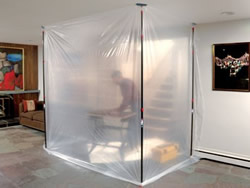
Enclosure is the easiest method. Lead paint is covered with flexible wall covering, paneling or gypsum board. Enclosure works best on large, flat surfaces that are not subject to friction.
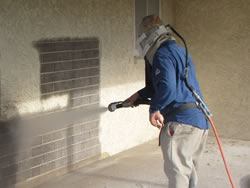
Paint Removal may be done on or off the work-site. On-site paint removal often creates large amounts of lead dust, fumes and mists. This is best left to the professionals. This can be done by sandblasting surfaces or scraping the paint off.
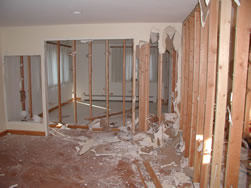
Replacement involves removing the object coated with lead paint entirely and replacing it with new material. It’s one of the best methods for doors, windows, and moldings.
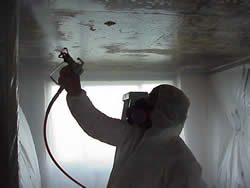
Encapsulation covers and seals lead paint with a special coating. It is less expensive than more thorough methods of abatement, but not suitable for surfaces subject to friction.